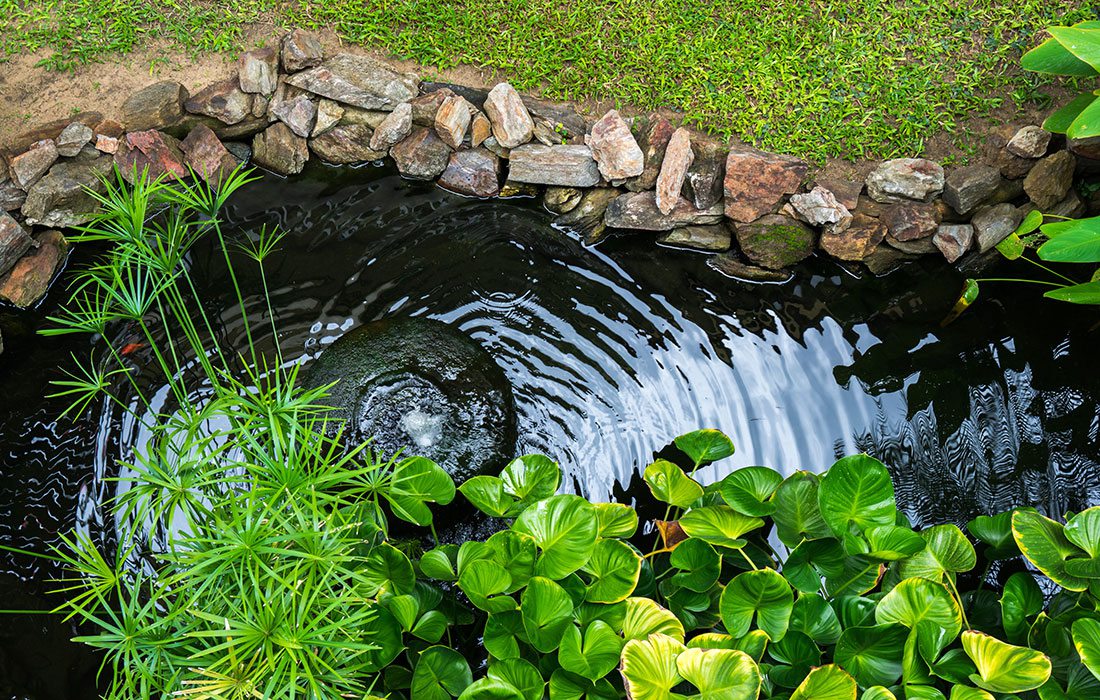
Outdoors
Tips and Tricks to Installing an Outdoor Water Garden
We called on resident water garden expert Linda Siler from Wickman’s Garden Village to give us the scoop on how you can create a lovely outdoor oasis to enjoy through spring and summer.
By Haley Phillips
Mar 2020

What should I know before installing a water garden in my backyard?
The phrase “location, location, location” isn’t just for real estate. It’s also the first step in deciding where to build your water garden. Linda Siler, water garden specialist at Wickman’s Garden Village, suggests staying away from low spots and shady areas. This will prevent leaves and debris from getting caught in the garden, meaning less work for you and your water garden’s filter. The next step is to decide your budget.
If you plan to have it professionally installed, Siler advises finding someone experienced. “Make sure they’ve done it before,” Siler says. “Usually professionals will have a portfolio of the gardens they’ve done before, and you’re able to contact previous customers.”
If you decide on DIY, still seek expert advice and not just from your search engine, Siler cautions. “If you’re going to get your information from Googling, just know it’s an opinion, not a fact,” she says. Other things to consider: You’ll need a power and water source to keep equipment, like a water filter and pump, running smoothly. Speaking of which…
What equipment do I need?
Siler encourages first-time water gardeners to work with local specialists to ensure proper equipment is used for the project. First on the to-do list: grab a garden hose and channel your inner Joanna Gaines. Using the long, flexible tube, map out the garden’s design and get an outline that fits the space. Knowing the dimensions will help your specialist establish what size liner you’ll need and how many gallons of water you’ll have in the space. “Everything is based off how many gallons of water will be in your feature,” Siler says. This is especially important to know when choosing the correct pump size and filtration system. Equally as important is the cleanliness of the water. “If you don’t biologically filter the water, you’ll have a mess on your hands,” Siler says. Adding beneficial bacteria to your water will stabilize the water’s quality, which fluctuates with the presence of fish in your water garden. “All the chemicals are budget-friendly, and the bacteria is conducive to water quality, so you’ll have a happy, healthy, pretty pond,” Siler says.
What types of plants should I plant in and around the water garden?
Acting as natural filters to remove excess nitrogen from the water, water plants are not only aesthetically pleasing but also a great way to control algae growth and add oxygen back in to your garden.
When deciding on what plants to use, Siler recommends using an assortment of the four main types of water plants. Submerged plants, like hornwort, spend their entire life underneath the surface of the water. Hovering on the water’s surface, floating plants like the water hyacinth provide surface cover and improve water clarity. The waterlily, a fan-favorite example of an emergent plant, grows deep roots and gorgeous wide blooms to provide shade for your fishie friends.
To give your water garden a finished look, place marginal plants like irises and cattails along the shoreline. Keep in mind, most varieties of water plants require four to six hours of sunlight.
How can I include fish in my water garden?
Introducing fish into your water garden is always a fun element for kids and adults, but it does require planning. What kind of fish you decide to include in your water feature is dependent on the size of the garden, with species like koi and goldfish requiring a larger area.
As the water draws in other wildlife, the chance for harmful parasites to appear increases. “We want to create a healthy atmosphere for the fish,” Siler says. “Make sure that you have a good biologically balanced pond.” Always contact a specialist with questions about caring for fish.












